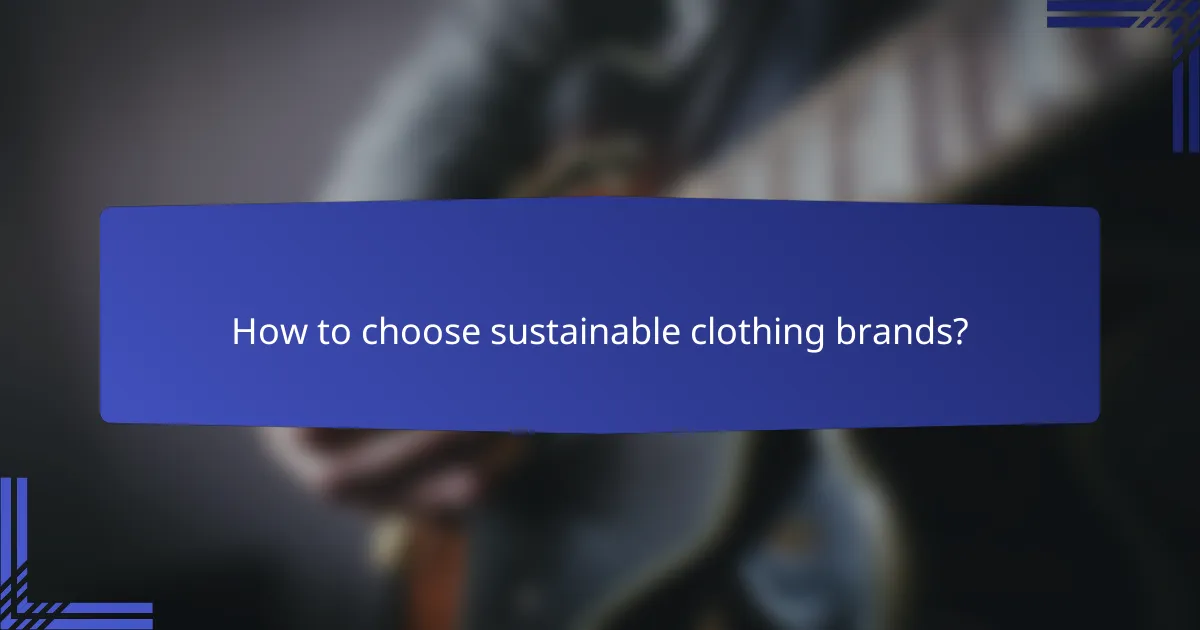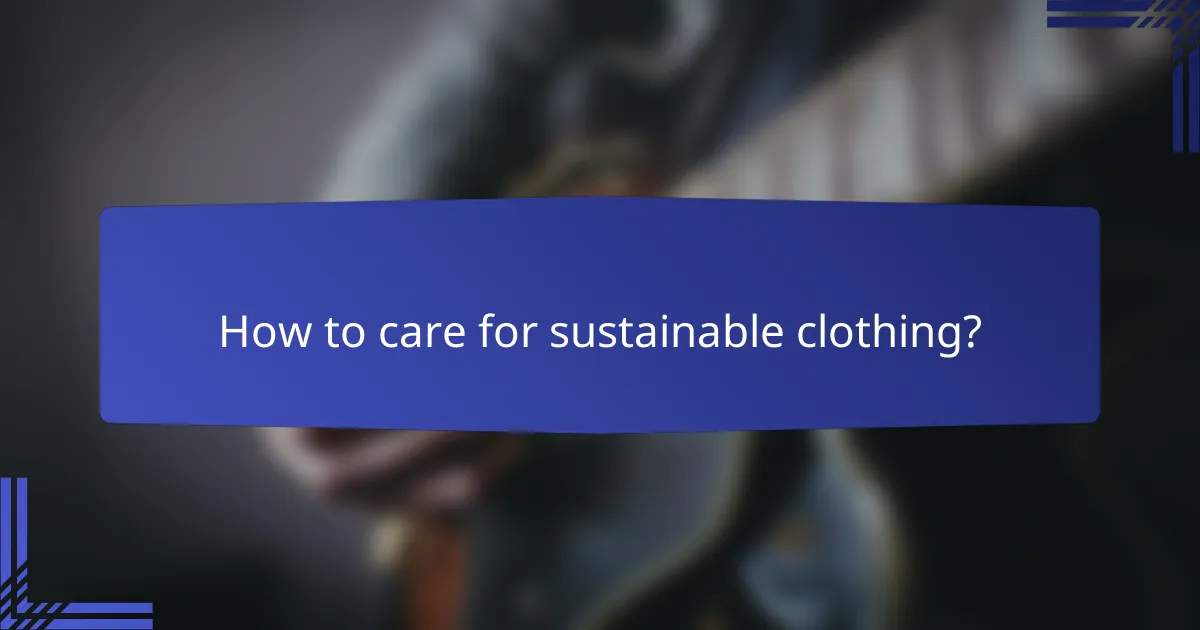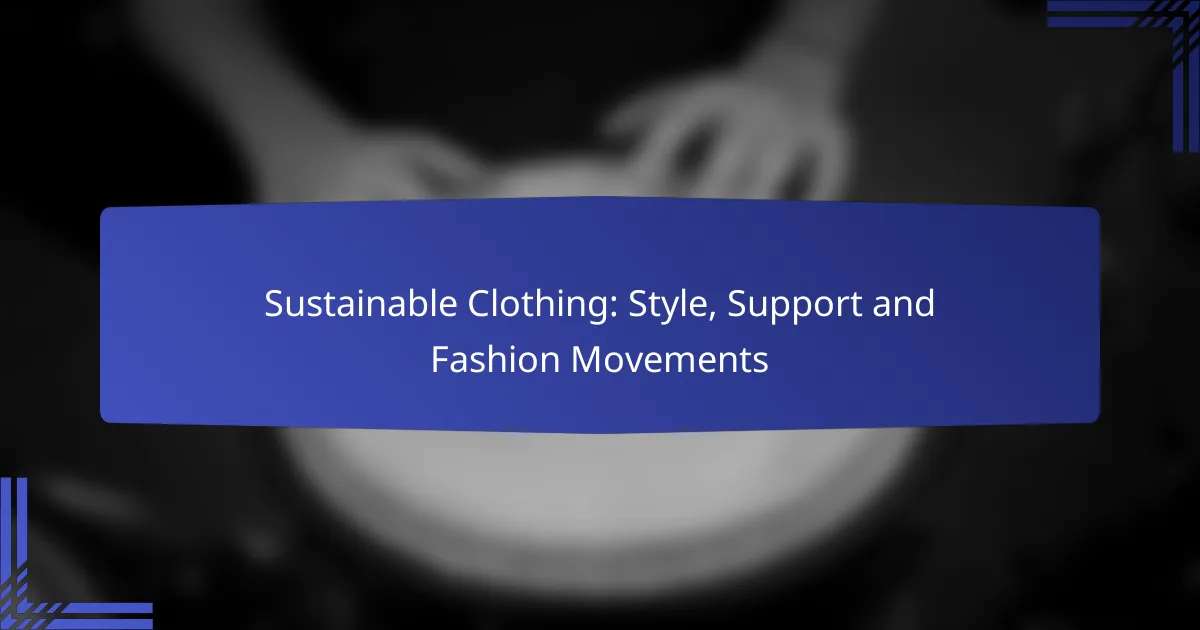Sustainable clothing is revolutionizing the fashion industry by emphasizing eco-friendly practices and ethical consumption. By selecting brands that prioritize environmental responsibility and fair labor, consumers can enjoy stylish options while contributing to a healthier planet. This movement not only reduces the environmental footprint but also encourages a shift away from fast fashion towards more durable and meaningful choices.

How to choose sustainable clothing brands?
To choose sustainable clothing brands, look for those that prioritize environmental and social responsibility in their practices. Key factors include eco-friendly certifications, transparency in supply chains, the use of organic materials, and a commitment to fair labor practices.
Brands with eco-friendly certifications
Brands that hold eco-friendly certifications demonstrate their commitment to sustainable practices. Look for labels such as Global Organic Textile Standard (GOTS), OEKO-TEX, or Fair Trade, which indicate adherence to rigorous environmental and social standards.
These certifications often require brands to meet specific criteria regarding material sourcing, chemical use, and labor conditions. Checking for these labels can help you identify brands that genuinely prioritize sustainability.
Transparency in supply chains
Transparency in supply chains is crucial for assessing a brand’s sustainability. Brands that openly share information about their sourcing, manufacturing processes, and labor conditions allow consumers to make informed choices.
Look for brands that provide detailed information on their websites about where and how their products are made. This transparency can include factory locations, labor practices, and environmental impact assessments.
Use of organic materials
Brands that use organic materials contribute to sustainability by reducing the use of harmful chemicals and promoting biodiversity. Organic cotton, hemp, and linen are examples of materials that are often grown without synthetic pesticides or fertilizers.
When shopping, prioritize brands that clearly state their use of organic materials in their products. This not only supports sustainable agriculture but also often results in higher-quality textiles.
Commitment to fair labor practices
A commitment to fair labor practices is essential for sustainable clothing brands. This includes ensuring fair wages, safe working conditions, and the right to unionize for workers in the supply chain.
Look for brands that are certified by organizations like Fair Trade or those that publish their labor policies and audit results. Supporting brands that prioritize ethical labor practices helps promote social responsibility in the fashion industry.

What are the benefits of sustainable clothing?
Sustainable clothing offers numerous advantages, including a reduced environmental footprint, support for ethical labor practices, and enhanced durability. By choosing sustainable options, consumers can contribute to a healthier planet and fairer working conditions.
Reduced environmental impact
Sustainable clothing significantly lowers the environmental impact associated with traditional fashion. This includes minimizing water usage, reducing carbon emissions, and decreasing waste through the use of eco-friendly materials and production methods.
For example, organic cotton requires less water and no harmful pesticides compared to conventional cotton. Additionally, brands that adopt circular fashion principles aim to recycle materials, further reducing waste in landfills.
Support for ethical labor
Choosing sustainable clothing often means supporting brands that prioritize ethical labor practices. These companies typically ensure fair wages, safe working conditions, and respect for workers’ rights throughout their supply chains.
Consumers can look for certifications such as Fair Trade or GOTS (Global Organic Textile Standard) to identify brands committed to ethical labor. This not only helps improve the lives of workers but also promotes a more equitable fashion industry.
Long-lasting quality
Sustainable clothing is designed to last longer than fast fashion alternatives, which often prioritize low cost over durability. Higher-quality materials and craftsmanship result in garments that withstand wear and tear, reducing the need for frequent replacements.
Investing in sustainable pieces can save money in the long run, as they typically require less frequent purchases. Look for items made from robust fabrics like organic cotton, Tencel, or recycled polyester to ensure longevity.

How does sustainable clothing impact fashion trends?
Sustainable clothing significantly influences fashion trends by promoting eco-friendly practices and ethical consumption. This shift encourages consumers to prioritize quality and longevity over fast fashion, leading to a more mindful approach to style.
Shift towards minimalism
The trend towards minimalism in fashion emphasizes simplicity and functionality, often featuring neutral colors and clean lines. This approach not only reduces waste but also encourages consumers to invest in versatile pieces that can be worn in multiple ways.
Minimalist wardrobes typically consist of a limited number of high-quality items, allowing for easier outfit coordination and reducing the impulse to buy unnecessary clothing. Brands are responding by offering capsule collections that focus on timeless designs rather than fleeting trends.
Rise of circular fashion
Circular fashion promotes the idea of reusing and recycling materials to create new garments, minimizing waste in the fashion industry. This model encourages brands to design products with their entire lifecycle in mind, ensuring that items can be repaired, reused, or recycled.
Consumers can support circular fashion by choosing brands that offer take-back programs or by purchasing second-hand clothing. This not only extends the life of garments but also reduces the demand for new resources, aligning with sustainable practices.
Popularity of upcycled materials
Upcycled materials are gaining popularity as designers seek innovative ways to repurpose existing textiles into new fashion items. This practice not only reduces waste but also adds unique character to each piece, appealing to consumers looking for individuality in their clothing.
Brands are increasingly showcasing collections made from upcycled fabrics, often highlighting the stories behind the materials. Shoppers can look for labels that emphasize upcycling to make more environmentally conscious choices while enjoying distinctive styles.

What are the key sustainable materials?
Key sustainable materials include organic cotton, Tencel, and recycled polyester, each offering unique environmental benefits. These materials are designed to reduce the ecological impact of clothing production while maintaining quality and style.
Organic cotton
Organic cotton is grown without synthetic pesticides or fertilizers, making it a more environmentally friendly alternative to conventional cotton. This method promotes biodiversity and healthier soil, which can lead to improved crop resilience.
When purchasing organic cotton clothing, look for certifications such as GOTS (Global Organic Textile Standard) to ensure the product meets strict environmental and social criteria. While organic cotton may be slightly more expensive, the benefits to the environment and farmers can be significant.
Tencel
Tencel, made from sustainably sourced wood pulp, is known for its softness and breathability. The production process uses a closed-loop system that recycles water and solvents, minimizing waste and pollution.
Clothing made from Tencel is biodegradable and often feels luxurious against the skin. When shopping, check for brands that highlight their sustainable practices and sourcing to ensure you are making an eco-friendly choice.
Recycled polyester
Recycled polyester is produced from post-consumer plastic waste, such as bottles, reducing the need for virgin materials and diverting waste from landfills. This material helps lower carbon emissions associated with textile production.
When considering recycled polyester, look for certifications like the Global Recycled Standard (GRS) to verify the content and sustainability of the fabric. While it may not be as breathable as natural fibers, it offers durability and moisture-wicking properties, making it suitable for activewear.

How to care for sustainable clothing?
Caring for sustainable clothing involves specific practices that help extend the lifespan of garments while minimizing environmental impact. Proper washing, using eco-friendly detergents, and appropriate storage are essential steps to maintain the quality and sustainability of your wardrobe.
Washing techniques to extend lifespan
To extend the lifespan of sustainable clothing, wash items in cold water whenever possible. This reduces energy consumption and helps prevent fading and shrinking. Additionally, consider using a gentle cycle to minimize wear and tear on the fabric.
Avoid overloading the washing machine, as this can cause friction and damage. Instead, wash smaller loads to ensure each garment gets the care it needs. If possible, air-dry your clothes to prevent the heat from a dryer from causing fabric deterioration.
Eco-friendly detergents
Using eco-friendly detergents is crucial for caring for sustainable clothing. These detergents are typically biodegradable and free from harsh chemicals, making them safer for the environment and your skin. Look for products labeled as non-toxic and phosphate-free.
When selecting a detergent, consider those that come in minimal or recyclable packaging to further reduce waste. Many brands offer concentrated formulas, which require less product per wash, making them a more sustainable choice.
Proper storage methods
Proper storage is essential for maintaining the quality of sustainable clothing. Store garments in a cool, dry place away from direct sunlight to prevent fading and fabric degradation. Use breathable garment bags for delicate items to protect them from dust and pests.
For seasonal clothing, consider using acid-free tissue paper to help maintain shape and prevent creasing. Avoid hanging heavy items, as this can stretch the fabric; instead, fold them neatly to preserve their structure.

What are the challenges of sustainable fashion?
Sustainable fashion faces several challenges, including high production costs, limited consumer awareness, and the complexity of supply chains. These factors can hinder the growth and accessibility of eco-friendly clothing options.
High Production Costs
The production of sustainable clothing often involves higher costs due to the use of organic materials, ethical labor practices, and environmentally friendly processes. Brands may pass these costs onto consumers, resulting in higher retail prices compared to conventional fashion.
For example, a sustainably produced t-shirt might cost 30-50% more than a standard one. This price difference can deter budget-conscious shoppers, despite the long-term benefits of investing in quality, eco-friendly garments.
Limited Consumer Awareness
Many consumers are still unaware of the environmental impact of fast fashion and the benefits of sustainable alternatives. This lack of awareness can lead to a preference for cheaper, mass-produced clothing options.
Education and outreach are crucial in promoting sustainable fashion. Brands can engage consumers through transparent marketing, highlighting the positive effects of choosing sustainable products on the environment and society.
Complex Supply Chains
Sustainable fashion often involves intricate supply chains that can be difficult to manage and monitor. Ensuring that every step of the process adheres to ethical and environmental standards requires significant effort and resources.
Brands must invest in traceability and certification to guarantee that their products are genuinely sustainable. This can involve collaborating with various stakeholders, from farmers to manufacturers, to create a cohesive and responsible supply chain.
